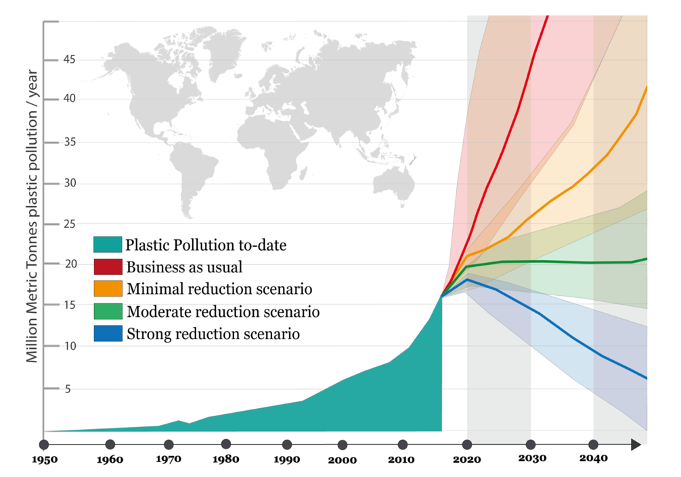Report of RNRF Round Table: Meeting the Challenge of Microplastic Management to Protect Human Health and the Environment

Scott Coffin, a research scientist at the California State Water Resources Control Board, spoke at a virtual meeting of the Washington Round Table on Public Policy on June 23, 2021. He discussed the initial steps being taken toward managing microplastics in California, as well as the challenges and barriers to regulating microplastics under traditional regulatory paradigms. He also discussed potential changes in approaches to better regulate complex and persistent contaminant classes like microplastics for the protection of human health and the environment.
History and Background
Coffin began by giving a brief history of plastic, microplastics, and early studies that began to raise alarm over their environmental impact. Single-use plastic started being used substantially in 1955, touted as a “cure” for the inconvenience of many household chores. If a plastic item was dirty, you could just throw it ‘away.’ This was the beginning of a societal change toward the widespread adoption of single-use, disposable plastics.
Figure 1: Plastic Pollution Increases Exponentially
Only five years later, in 1960, the first scientific study was published which demonstrated that plastics can cross barriers in the body and be taken up into the cells of the intestines and liver.[i] This began to prompt concern that plastic particles could be harmful to human health.
In 1969, less than twenty years after the widespread use of plastic began, researchers in Hawaii found that 90 of the 91 Laysan Albatross they studied had identifiable pieces of plastic in their gut.[ii] This caused people to begin questioning whether the widespread use of plastic in society could be sustainable.
Since then, plastic pollution has only continued to increase exponentially with time. Under a business-as-usual pathway, the volume of plastic expelled into the environment is expected to double by 2040. However, it is possible to change the trajectory of plastic production and pollution and work toward a more sustainable future. Figure 1 demonstrates some possible pathways.
Scientists have been studying plastics, including their impacts on the environment and human health, for decades. However, there are still no regulations on microplastics anywhere in the world. As a class of contaminants, microplastics are very difficult to regulate. Coffin identified four main factors that make assessing and managing the risks of microplastics very challenging, preventing meaningful regulation over the years. These are: ubiquity, complexity, secrecy, and persistence. Throughout his presentation, Coffin gave examples of each barrier and proposed solutions for how we can potentially overcome them.
Plastic in Air, Water, and Food
Plastic can be found everywhere on earth, from the deepest parts of the ocean to the tallest mountain in the world, and everywhere in between. Plastic is constantly being broken down into smaller and smaller pieces, until eventually they are micro and nano-sized particles that can only be viewed through a microscope and can never be recovered from the environment. Microplastic particles are often so small that they can be transported by the wind and the rain – a 2020 study found that plastic exists in the air in U.S. national parks at relatively high concentrations, many miles away from their sources.[iii] Plastics have also been found in the air in Antarctica and the Arctic, suggesting that they are being transported globally.
Plastics are also ubiquitous in water around the world. They can enter surface water through many different pathways: rainfall and settling from the air are common, as well as stormwater, wastewater, and littering. Once plastic has entered a body of water, it typically continues to break down into smaller pieces. Microplastics exist at the surface of bodies of water, as well as suspended and buried in sediment. They can also make their way from the environment into surface drinking water reservoirs.
Wastewater treatment plants are typically very effective at removing microplastics. They can remove up to 99% of microplastics from water, depending on the type of facility.[iv] However, the sludge (treated waste residue removed from the water during the treatment process) that comes from these plants is often converted to biosolids, nutrient-rich materials that are frequently used as fertilizer. A recent study found that the concentration of plastic in biosolids has risen over the past few decades, closely correlating with rates of global plastic production.[v] Another study found that plants can uptake microplastics through their roots, prompting concern that biosolids could be transferring microplastics to the food we eat. Microplastics in soil can also stunt plant growth and decrease fruit production, raising concern over future food security.[vi]
California’s Efforts to Manage Microplastics
In 2018, California passed two laws related to the management of microplastic pollution. California Senate Bill 1263 is focused on microplastic pollution in marine environments. It requires the California State Water Resources Control Board to collaborate with the Ocean Protection Council to initiate a statewide microplastics strategy by the end of 2022. By the end of 2026, they are required to develop a risk assessment framework, develop standardized methods for monitoring microplastics, establish baseline occurrence data to know where microplastics occur in the environment, investigate sources and pathways for microplastic pollution, and recommend source reduction strategies to the California legislature.
Developing a risk assessment framework for microplastics in marine environments is expected to be a serious challenge. Microplastic exposure in the environment is very heterogeneous: exposure can vary significantly based on where you look. Microplastics and other particles in the ocean tend to accumulate in natural circular ocean currents (gyres). There are 5 major ocean gyres, and one is unlikely to encounter significant levels of plastic pollution in the open ocean outside of those gyres. The heterogeneity of environmental exposure makes assessing risk a complex endeavor. Additionally, most models account for only about 1% of ocean plastic because they largely observe the plastic that is floating near the surface. Due to fragmentation and biofouling, plastic in the ocean becomes denser over time and falls beneath the surface, often all the way to the seabed, where it can enter sediment and affect benthic communities. The ubiquity and persistence of microplastics in the environment also makes risk assessment more challenging.
The other law passed in 2018, California Senate Bill 1422, requires the California State Water Resources Control Board (State Water Board) to take action on microplastics in drinking water. This is a concerning yet poorly understood issue, especially in the United States – a 2017 study found that 94% of tap water samples in the U.S. contained microplastics, compared to 83% of samples worldwide.[vii]
Figure 2: Plastic Fibers in Tap Water, 2017
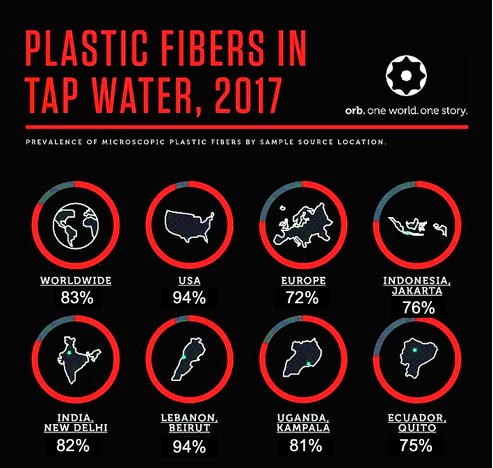
The law’s implementation began with a requirement to define “microplastics” by July 1, 2020. It is rare for environmental contaminant classes not to have a harmonized definition but the complexity of microplastics made defining them a relatively difficult task. They are composed of countless different polymers and have different distributions of size, shape, color, adsorbed contaminants, and other factors that need to be taken into account. California adopted the following definition of “microplastics in drinking water”:
“Solid polymeric materials to which chemical additives or other substances may have been added, which are particles which have at least three dimensions that are greater than 1 nanometer and less than 5,000 micrometers. Polymers that are derived in nature that have not been chemically modified (other than by hydrolysis) are excluded.” – California State Water Resources Control Board, 2020
This is a very broad definition, covering chemicals from 1 nanometer to about the size of a human thumb. It includes particles of all “traditional” plastics, including any plastic product with the “chasing arrows” symbol often associated with recycling (although they do not necessarily mean that a piece of plastic can be recycled). It also includes “non-traditional” plastics that do not have the chasing arrows symbol, including synthetic rubber (used in automobile tires) as well as the synthetic fibers in clothing, silicones, bio-based and biodegradable polymers, and cellulose acetate (most commonly found in cigarette filters).
The definition of microplastics adopted by the state of California was similar to one recently proposed by the European Chemicals Agency (ECHA) to restrict the types of microplastics that can be intentionally added to products. However, ECHA provides an exclusion for chemicals that are biodegradable, under the presumption that the persistence of chemicals in the environment is what determines their toxicity. California did not exempt biodegradable polymers from its definition. To explain this decision, Coffin cited a 2020 study which asked whether bioplastics are safer than conventional plastics. The study examined a suite of conventional petroleum-based plastics and bioplastics of various product types and looked for endocrine disrupting activity and other concerning impacts. They found that overall, there is no discernable difference in toxicity between conventional plastics and bioplastics.[viii] Many bioplastics, like conventional plastics, contain hazardous chemicals. Just because a product biodegrades does not mean that it is not harmful.
By July 1, 2021, SB 1422 mandates that the California State Water Board adopt a standardized method to monitor microplastics. In the Q&A session Coffin said that this deadline has been delayed due to the pandemic but they are still aiming to complete it by the end of fall 2021. Previously, no such standard existed, so the State Water Board launched a method development and standardization project. It focuses on four matrices for microplastic pollution: drinking water, ocean water, fish tissue, and sediment. Coffin noted that having a standardized method for monitoring a contaminant is a critical first step toward being able to manage it. Over 40 organizations are participating in this process, including government agencies, academia, plastic manufacturers, and others.
Coffin then explained what is involved in identifying plastics in the environment. Typically, to identify a polymer, you must match it to one that has been identified and exists in a library of polymer types. It can be challenging to identify all types of plastics, especially if they contain dyes or other additives. Over 37,000 polymers are used in commerce, but around 20-25 of them are by far the most common. Many of the libraries available to identify polymers are very expensive and proprietary, so the scientific community has begun to invest in open access alternatives. This is a step toward circumventing the secrecy that has been gatekeeping knowledge about plastics in the environment for decades.
Evaluating Health Impacts of Microplastics
When California starts monitoring microplastics and reporting that data to the public, people will certainly wonder what microplastic exposure means for their health, if they were not already. This is why the California senate recommended the State Water Board consider developing a health-based guidance level for microplastic exposure as a part of SB 1422.
In 2019, the World Health Organization (WHO) released a report about microplastics in drinking water.[ix] At the time, there was very limited information available about microplastics, especially related to their impacts on human health. The report concluded the following: “Humans have ingested microplastics and other particles in the environment for decades with no related indication of adverse health effects… [there is] no evidence to indicate a human health concern.” Coffin explained that this argument is a fallacy – a lack of evidence against something does not necessarily mean that it is true.
In order to move past this fallacy and give better information to the public, the State Water Board is conducting a workshop with experts from around the world about the health impacts of microplastics. They are evaluating impacts of microplastics on both human and ecosystem health. This workshop will help inform the development of thresholds and regulations.
Figure 3: Rapidly Developing Science
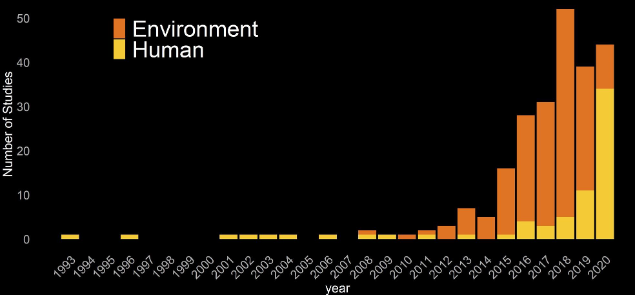
Just in the past few years, the number of toxicity studies about microplastics has risen exponentially. Very few studies about the impacts of microplastics on mammals had been published prior to 2019, so the WHO report mentioned by Coffin has access to limited information. Since then, the number of mammalian toxicity studies published on the topic has more than tripled. Coffin believes that this trend of more microplastics studies being published will continue in the future, and this will allow us in the coming years to learn a lot more about how microplastics impact human and ecosystem health.
Before describing our current understanding of the human health impacts of microplastics, Coffin defined the language used to address the topic. Risk, or the probability that something will cause harm, comes about by the combination of two other components: hazard and exposure. Hazard is defined as the potential to cause harm. However, if exposure to the hazard never happens, there is no risk. Simply put: Hazard x Exposure = Risk.
Exposure
There has been a wide range of studies examining the various ways that humans are exposed to microplastics. Everyone is exposed to microplastics from water, air, food, etc. at different rates due to a variety of factors. For instance, some people drink a lot of water from plastic bottles, while others do not. A recent study found that microplastic exposure risks were, on average, higher in bottled water than tap water. This is because the plastic packaging of bottled water releases microplastics, both into the water and into the air when the bottle is opened. Therefore, somebody who drinks bottled water is typically more likely to be exposed to microplastics than someone who drinks from the tap.[x]
Alarmingly, a similar observation has been made for polypropylene infant feeding bottles, some of which release enough microplastics to expose some small children to millions of particles daily.[xi] While the hazard component of evaluating this risk is not yet well understood, infants may potentially be exposed to higher amounts of microplastics than people at later life stages, making them a sub-population potentially at high risk.
Inhalation is likely the most significant exposure pathway for microplastics, more so than drinking water. Most of this exposure happens indoors through household dust: between 1.5% and 13% of dust is composed of microplastics. Indoor air typically has about 15 times more microplastics than outdoor air. The majority of this comes from fibers that shed from our clothing, upholstery, carpets, and rugs.[xii]
Another very important factor in evaluating microplastic risk is that they are persistent in human bodies. Our bodies do not break them down, so over our lifetimes, we tend to continuously accumulate more microplastics. This results in between 535 and 9,330,000 microplastic particles in the body of the average person.[xiii] There is also evidence that microplastics can be transferred across generations – identifiable levels have been found in human placentas.[xiv]
Hazard
Coffin then described the hazard component of assessing microplastic risk. Hazard is defined as the potential to cause harm to humans and aquatic organisms. There are two main types of microplastic hazards: particle and chemical hazards. This contributes to the complexity that can make assessing risk difficult.
Chemical Hazards
Plastic often contains hazardous chemicals. There are at least 3,300 known chemical additives to plastics. At least 33 plastic-associated contaminants are known to be hazardous; 7 are persistent, bioaccumulative, and toxic; and 15 are endocrine disrupting. It is especially difficult to assess risk for endocrine disrupting chemicals (EDCs). EDCs are defined as chemicals that mimic a hormone in the body. For instance, the common plastic additive bisphenol A (BPA) is chemically similar to estrogen, and elicits a similar bodily response. In fact, BPA was originally developed as a form of birth control. It was phased out of use when a more potent birth control was developed but years later it was discovered to be a useful plastic additive and made its way into many food-contact materials.
It is especially difficult to evaluate the health impacts of EDCs because they do not function in the body like a typical toxicant. The health impacts of a typical toxicant would become more severe as exposure increases. This is not always the case with EDCs. Often, severe health impacts can happen at very low doses of exposure. This makes assessing risk extremely challenging. In the United States, it causes us to typically underestimate our risk from EDCs.
Underestimating the health risks of EDCs has resulted in significant harm to society already. Between 2001 and 2016, PBDEs (a class of flame retardant that acts as an endocrine disruptor) resulted in between 750,000 and 1,750,000 intellectual disabilities. This is more than pesticides, mercury, and lead combined, and has resulted in an estimated $3.6 trillion loss to the economy based on healthcare costs and other indirect impacts, according to a 2020 study.[xv]
Examining known chemicals in plastics is concerning. However, the vast majority – over 85% – of plastic ingredients are confidential.[xvi] Their identities are not in any public database. A recently published study found that 53% of hazardous chemical additives are unregulated globally, accounting for an estimated 1,327 chemicals that are not regulated and are expected to cause harm for various reasons (due to being persistent, bioaccumulative, toxic, carcinogenic, endocrine disrupting, etc.).[xvii]
Figure 4: >85% of Plastic Ingredients are Confidential
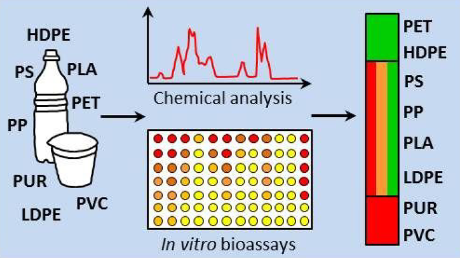
Particle Impacts
Coffin then discussed the particle impacts of microplastics. Microplastics can have different health effects depending on the size and type of organism that is exposed. Impacts can be explained by at least two hypothesized types of effect mechanisms: oxidative stress and food dilution. Oxidative stress is caused by exposure to particles that are so small, they can cause inflammation and cell death. This can lead to mortality, lack of reproduction, impaired development, and other impacts. Food dilution is when there is so much plastic in the gut of an organism that they cannot absorb nutrients from foods. While oxidative stress is likely to occur for humans, food dilution is likely to only be of concern for other organisms.
Studying Risk
Coffin then discussed the difficulties posed by the differences between how microplastics occur in the environment and how they are studied in a laboratory. The mixture of plastic in the environment is “polydisperse,” meaning that all shapes and sizes of microplastic exist in a continuous distribution. In a lab, they are “monodisperse” – only one type, or a set of specific types, is typically used. A set of particles studied in a lab is not going to be exactly the same as a set of particles in the environment. This presents a significant complexity that Coffin believes has impeded progress on assessing microplastic risk for a long time.
In 2019, a significant advancement was made to address this nonalignment. Scientists found that microplastics have predictable behaviors in the environment. They found that researchers can make probability alignments using distribution functions to compare lab experiments to the real world.[xviii] This was a big step forward in assessing microplastic risk.
Microplastics are persistent in the environment, meaning that risk assessments need to evaluate future environmental occurrence scenarios as well as present conditions. In general, plastic degrades very slowly in the ocean. Its degradation period is estimated to be as long as 1,400 years. Probability and severity of risk rises as more plastic accumulates with time, making modelling scenarios for the future important to protecting future generations.[xix]
Figure 5: Plastic Degrades Very Slowly in the Ocean
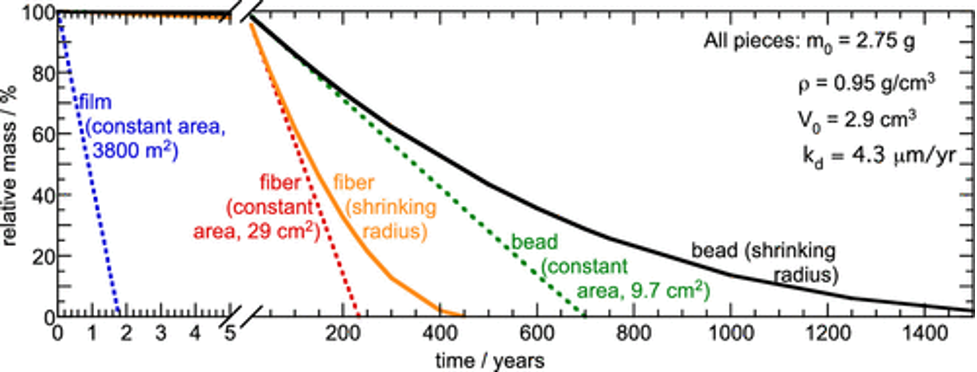
Microplastics as a Non-Threshold Contaminant
In Coffin’s words, addressing issues related to plastic pollution can sometimes feel like pushing a boulder up a hill. There are countless challenges for assessing and managing risks for microplastics. It can feel like a Sisyphean task for risk assessors. Addressing the issue in a meaningful way will require a paradigm shift in how we approach it.
This paradigm shift may require the adoption of a more precautionary approach to managing microplastics. While it may be a decade or longer before we have a concrete idea of the risks that microplastics pose to human health and the environment, exposure is happening right now and is only expected to increase. In 2019, the European Chemicals Agency recognized this and defined plastic as a “non-threshold contaminant,” a precautionary definition that means that no safe level of discharge exists. Effectively, the goal of such a definition is to work toward having zero input of microplastics into the environment.
In the Q&A session of the round table, Coffin noted that universally defining microplastics as a non-threshold contaminant would not necessarily mean that they need to be phased out entirely. He compared plastic to PFAS, which is used for everything from swim trunks to essential medical equipment. Obviously, the necessities of these uses are not equivalent. For plastics, there are use cases where a better, more sustainable alternative exists. Many single-use plastic products have better alternatives, and due to their unnecessary use have played a significant role in bringing us to the unsustainable plastic pollution levels of today.
Conclusion
Microplastics are everywhere, they are extremely complex, they are persistent, and they contain secret chemicals which make assessing and managing risk extremely challenging. We can begin to address this issue through inter-sector collaboration and open data. However, to manage the risks that microplastics pose we may need to rethink our paradigms of risk assessment. Because they do not break down quickly on a molecular level, their environmental concentrations will only increase with time. The earlier action is taken to manage microplastics, the more likely we will be able to avoid their ill effects on the environment and human health.
– Stephen Yaeger, RNRF Program Manager
To access the PowerPoint Coffin used during his presentation, click here.
Timelines of California Microplastic Legislation
California Senate Bill 1263 (2018)
2022:
- Initiate Statewide Microplastics Strategy
2026:
- Develop risk assessment framework
- Develop standardized methods
- Establish baseline occurrence data
- Investigate sources and pathways
- Recommend source reduction strategies
California Senate Bill 1422 (2018)
2020:
- Define ‘microplastics’
2021:
- Standardize method
- Four years of testing
- Health-based guidance level
- Accredit laboratories
References
[i] E. Sanders, C.T. Ashworth, “A study of particulate intestinal absorption and hepatocellular uptake: Use of polystyrene latex particles,” Experimental Cell Research 22 (1961): 137-145. https://doi.org/10.1016/0014-4827(61)90092-1.
[ii] Karl W. Kenyon, Eugene Kridler, “Laysan Albatrosses swallow indigestible matter,” The Auk 86, no. 2 (1969): 339-343. https://doi.org/10.2307/4083505.
[iii] Janice Brahney, Margaret Hallerud, Eric Heim, Maura Hahnenberger, Suja Sukumaran, “Plastic rain in protected areas of the United States,” Science 368, no. 6496 (2020): 1257-1260. https://doi.org/10.1126/science.aaz5819.
[iv] Shirra Freeman, Andy Booth, Isam Sabbah, Rachel Gjelsvik Tiller, “Between source and sea: The role of wastewater treatment in reducing marine microplastics,” Journal of Environmental Management 266 (2020). http://dx.doi.org/10.1016/j.jenvman.2020.110642.
[v] Elvis D. Okoffo, Erica Donner, Steve P. McGrath, Benjamin J. Tscharkea, Jake W. O’Brien, Stacey O’Brien, Francisca Ribeiroa, Stephen D. Burrows, Tania Toapanta, Cassandra Rauert, Saer Samanipour, Jochen F. Mueller, Kevin V. Thomas, “Plastics in biosolids from 1950 to 2016: A function of global plastic production and consumption,” Water Research 201 (2021). https://doi.org/10.1016/j.watres.2021.117367.
[vi] Xiao-Dong Sun, Xian-Zheng Yuan, Yuebin Jia, Li-Juan Feng, Fan-Ping Zhu, Shang-Shang Dong, Jiajia Liu, Xiangpei Kong, Huiyu Tian, Jian-Lu Duan, Zhaojun Ding, Shu-Guang Wang & Baoshan Xing, “Differentially charged nanoplastics demonstrate distinct accumulation in Arabidopsis thaliana,” Nature Nanotechnology 15 (2020): 755-760). https://doi.org/10.1038/s41565-020-0707-4.
[vii] Chris Tyree, Dan Morrison, “Invisibles: The Plastic Inside Us,” Orb Media (2017). https://orbmedia.org/stories/Invisibles_plastics/.
[viii] Lisa Zimmermann, Andrea Dombrowski, Carolin Völker, Martin Wagner, “Are bioplastics and plant-based materials safer than conventional plastics? In vitro toxicity and chemical composition,” Environment International 145 (2020). https://doi.org/10.1016/j.envint.2020.106066.
[ix] World Health Organization, “Microplastics in Drinking Water” (2019). https://www.google.com/url?sa=t&rct=j&q=&esrc=s&source=web&cd=&ved=2ahUKEwiKkMfAqtHxAhXGB80KHXjjBooQFjAIegQIAxAD&url=https%3A%2F%2Fapps.who.int%2Firis%2Frest%2Fbitstreams%2F1243269%2Fretrieve&usg=AOvVaw1QDLN5T2RfjDPC6BycORi6
[x] Zahra Sobhani, Yongjia Lei, Youhong Tang, Liwei Wu, Xian Zhang, Ravi Naidu, Mallavarapu Megharaj, Cheng Fang, “Microplastics generated when opening plastic packaging,” Scientific Reports 10, no. 4841 (2020). https://doi.org/10.1038/s41598-020-61146-4.
[xi] Dunzhu Li, Yunhong Shi, Luming Yang, Liwen Xiao, Daniel K. Kehoe, Yurii K. Gun’ko, John J. Boland, Jing Jing Wang, “Microplastic release from the degradation of polypropylene feeding bottles during infant formula preparation,” Nature Food 1 (2020): 746-754. https://doi.org/10.1038/s43016-020-00171-y.
[xii] Sharareh Dehghani, Farid Moore, Razegheh Akhbarizadeh, “Microplastic pollution in deposited urban dust, Tehran metropolis, Iran,” Environmental Science and Pollution Research 24 (2017). https://doi.org/10.1007/s11356-017-9674-1.
[xiii] Nur Hazimah Mohamed Nor, Merel Kooi, Noël J. Diepens, Albert A. Koelmans, Lifetime Accumulation of Microplastic in Children and Adults, Environmental Science and Technology 55, no. 8 (2021): 5084-5096. https://doi.org/10.1021/acs.est.0c07384.
[xiv] Antonio Ragusa, Alessandro Svelato, Criselda Santacroce, Piera Catalano, Valentina Notarstefano, Oliana Carnevali, Fabrizio Papa, Mauro Ciro, Antonio Rongioletti, Federico Baiocco, Simonetta Draghi, Elisabetta D’Amore, Denise Rinaldo, Maria Matta, Elisabetta Giorginic, “Plasticenta: First evidence of microplastics in human placenta,” Environment International 146 (2021). https://doi.org/10.1016/j.envint.2020.106274.
[xv] Abigail Gaylord, Gwendolyn Osborne, Akhgar Ghassabian, Julia Malits, Teresa Attina, Leonardo Trasande, “Trends in neurodevelopmental disability burden due to early life chemical exposure in the USA from 2001 to 2016: A population-based disease burden and cost analysis,” Molecular and Cellular Endocrinology 502 (2020). https://doi.org/10.1016/j.mce.2019.110666.
[xvi] Lisa Zimmermann, Georg Dierkes, Thomas A. Ternes, Carolin Völker, Martin Wagner, “Benchmarking the in Vitro Toxicity and Chemical Composition of Plastic Consumer Products,” Environmental Science and Technology 53, no. 19 (2019). https://doi.org/10.1021/acs.est.9b02293.
[xvii] Helene Wiesinger, Zhanyun Wang, Stefanie Hellweg, “Deep Dive into Plastic Monomers, Additives, and Processing Aids,” Environmental Science and Technology 55, no. 13 (2021). https://doi.org/10.1021/acs.est.1c00976.
[xviii] Merel Kooi, Albert A. Koelmans, “Simplifying Microplastic via Continuous Probability Distributions for Size, Shape, and Density,” Environmental Science and Technology Letters 6, no. 9 (2019): 551-557. https://doi.org/10.1021/acs.estlett.9b00379.
[xix] Ali Chamas, Hyunjin Moon, Jiajia Zheng, Yang Qiu, Tarnuma Tabassum, Jun Hee Jang, Mahdi Abu-Omar, Susannah L. Scott, Sangwon Suh, “Degradation Rates of Plastics in the Environment,” ACS Sustainable Chemistry Engineering 8, no. 9 (2020): 3494-3511. https://doi.org/10.1021/acssuschemeng.9b06635.

